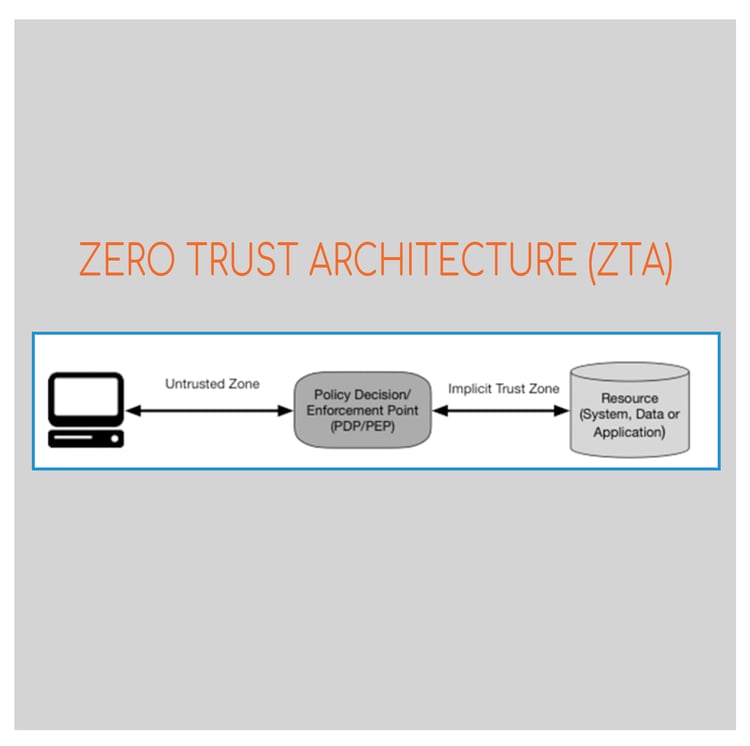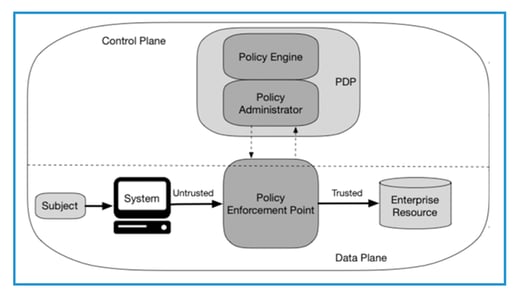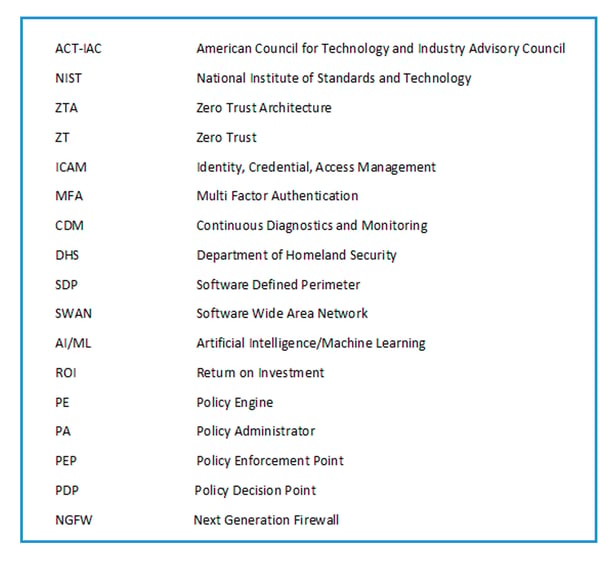
I have a deep interest in cybersecurity, and to keep up with the latest threats, policies and security practices, I became a member of ACT-IAC organization and enrolled in the Cybersecurity Community of Interest group. This is where I got the opportunity to work as a volunteer in the Zero Trust Architecture Phase 2 project. Hence, I am trying to share the knowledge I gained around ZTA strategy and principles. I am planning to break my blog into four series based on how the project progresses.
- What is ZTA?
- Real world deployment scenarios
- ZTA core capabilities
- Vendors providing ZTA capabilities
What is ZTA and how did it come into existence?
Traditionally, perimeter-based security has been used to protect the network infrastructure behind a firewall where if the user gets authenticated, they can access all the resources behind the firewall assuming all network users/devices as trustworthy. This caused a lot of security breaches across the globe where attackers could move laterally and exploit resources to which they were not authorized. The attackers only had to get through the firewall and later crawl across any resource available in the network causing potential damage in terms of data loss and other financial implications that can come via ransomware attacks.
Currently, an enterprise’s infrastructure operates around several networks like cloud-based services, remote users connecting from their own network using their enterprise-owned or personal devices (laptops, mobile devices), network location can change based on where the users/devices are connected from for e.g. public WIFI, internal enterprise networks etc. All these complex use cases made the possibility of moving away from perimeter-based security to “perimeter less” security (not confined to one network infrastructure) which led to the evolution of a new concept called as “Zero-Trust” where you “trust no one, but verify”. ZT approach is primarily based on data protection but it can be applied across other enterprise assets like users, devices, applications and infrastructure.
ZTA is basically an enterprise cybersecurity strategy that prevents data breaches and limits lateral movement within the network infrastructure. It assumes all the internal or external agents (user, device, application, infrastructure) that wants to access an enterprise resource (internal network or externally in the cloud) is not trustworthy and needs to be verified for each request before granting access to them.
What does Zero Trust mean in a ZTA?

(Image courtesy: NIST SP 800-27 publication)
In the above diagram, the user who is trying to access the resource must go through the PDP/PEP. PDP/PEP decides whether to grant access to this request based on enterprise policies (data/access/risk), user identity, device profile, location of the user, time of request and any other attributes needed to gain enough confidence. Once granted, the user is on an “Implicit Trust Zone” where it can access all the resources based on network infrastructure design. “Implicit Trust Zone” is basically the boarding area in an airport where all the passengers are considered trustworthy once they verify themselves through immigration/security check.
You can still limit access to certain resources in the network using a concept called “Micro-Segmentation”. For example, after getting through the security check and reaching the boarding area, passengers are again checked at the boarding gate to make sure they are entering the authorized flight to reach their destination. This is what “Micro Segmentation” means where the resources are more isolated to a segment and access requests are verified separately in addition to PDP/PEP.
Tenets of ZTA: (As per NIST SP 800-27 publication)
All the resources whether its data related, or services provided should be communicating in a secure fashion irrespective of their network location. Each individual access request will be verified before granting access to any resource based on the client’s identity, device they are using to request, type of application used, location coordinates and other behavioral attributes. Each access request granted will be authenticated and authorized dynamically and strictly enforced. In addition, the enterprise should collect all activity information, log decisions, audit logs and monitor the network infrastructure to improve the overall security posture.
What are the logical components of ZTA?

(Image courtesy: NIST SP 800-27 publication)
Policy Engine: Responsible to make and log decisions based on enterprise policy and inputs from external resources (CDM, threat intelligence etc.) to grant access or not to a request.
Policy Administrator: Responsible for establishing or killing the communication path between the subject and enterprise resource based on the decision made by PE. It can generate authentication tokens for the client to access the resource. PA communicates with PEP via the control plane.
Policy Enforcement Point: Responsible for enabling, monitoring and terminating communication between subject and enterprise resource. It can be either used as a single logical component or can be broken into two components: the client agent and resource gateway component that controls access. Beyond the PEP is the “Implicit Trust Zone” to access enterprise resources.
Control Plane/Data Plane: The control plane is made up of components that receive and process requests from the data plane components that wish to access network resources. The control and data planes are more like zones in the ZTA. All the resources, devices, and users within the network can have their own control plane component within them to decide whether the data should be routed further or not. In this diagram, it is just used to explain how control plane works for data plane components. Data plane simply passes packets around and the control plane routes them appropriately based on decisions made.
Note: The dotted line that you see in the image above is the hidden network that is used for communication between the various logical components.
Why should organizations adopt ZTA?
When adopting a ZTA, organizations must weigh all the potential benefits, risks, costs, and ROI. Core ZT outcomes should be focused on creating secure networks, securing data that travels within the network or at rest, reducing impacts during breaches, improving compliance and visibility, reducing cybersecurity costs and improving the overall security posture of an organization.
Lost or stolen data, ransomware attacks, and network and application layer breaches cost organizations huge financial losses and market reputation. It takes a lot of time and money for an organization to resume back to normal if the security breach was of the highest degree. ZT adoption can help organizations avoid such breaches which is the key to survive in today’s world, where state funded hackers are always ahead of the game.
As with all technology changes, the biggest challenge to demonstrate higher ROI and lower cybersecurity costs is the time needed to deliver the desired results. Organizations should consider the following:
- Assess what components of ZTA pillars they currently have in their infrastructure. Integration of components with existing tools can reduce the overall investment needed to adopt ZTA.
- Consider including costs or impacts associated with risk levels and occurrences when doing ROI calculations.
- ZT adoption should simplify, and not complicate, the overall security strategy to reduce costs.
What are the threats to ZTA?
ZTA can reduce the overall risk exposure in an enterprise but there are some threats that can still occur in a ZTA environment.
- Wrongly or mistakenly configured PE and PA could cause disruptions to the users trying to access the resources. Sometimes, the access requests which would get unapproved previously could get through due to misconfiguration of PE and PA by the security administrator. Now, the attackers or subjects could access resources from which they were restricted before.
- Denial of service attacks on PA/PEP can disrupt enterprise operations. All access decisions are made by PA and enforced by PEP to make a successful connection of a device trying to access a resource. If the DoS attack happens on the PA, then no subject would be able to get access as the service would be unavailable due to a flood of requests.
- Attackers could compromise an active user account using social engineering techniques, phishing or any other way to impersonate the subject to access resources. Adaptive MFA may reduce the possibility of such attacks on network resources but still in traditional enterprises with or without ZTA adoption, an attacker might still be able to access resources to which the compromised user has access. Micro-segmentation may protect resources against these attacks by isolating or segmenting the resource using technologies like NGFW, SDP.
- Enterprise network traffic is inspected and analyzed by policy administrators via PEPs but there are other non-enterprise-owned assets that can’t be monitored passively. Since the traffic is encrypted and it’s difficult to perform deep packet inspection, a potential attack could happen on the network from non-enterprise owned devices. ML/AI tools and techniques can help analyze traffic to find anomalies and remediate it quickly.
- Vendors or ZT solution providers could cause interoperability issues if they don’t follow certain standards or protocols when interacting. If one provider has a security issue or disruption, it could potentially disrupt enterprise operations due to service unavailability or the time taken to switch to another provider which can be very costly. Such disruptions can affect core business functions of an enterprise when working in a ZTA environment.
References
[ACT-IAC] American Council for Technology and Industry Advisory Council (2019) Zero Trust Cybersecurity Current Trends. Available at https://www.actiac.org/zero-trust-cybersecurity-current-trends
Draft (2nd 1) NIST Special Publication 800-207. Available at https://nvlpubs.nist.gov/nistpubs/SpecialPublications/NIST.SP.800-207-draft2.pdf
NIST Zero Trust Architecture Release: https://www.nccoe.nist.gov/projects/building-blocks/zero-trust-architecture

More from the blog
View All Blog PostsSaaS, PaaS, IaaS…Now what is RaaS (Ransomware as a Service)??
Continue ReadingEvolving to Zero Trust Architecture (ZTA) – Part 2
Continue ReadingOvercoming the Challenges of Acquiring Agile Digital Services in Government
Continue ReadingSubscribe to Our Blog
Fill out your email address to receive notifications about new blog posts from CC Pace!
